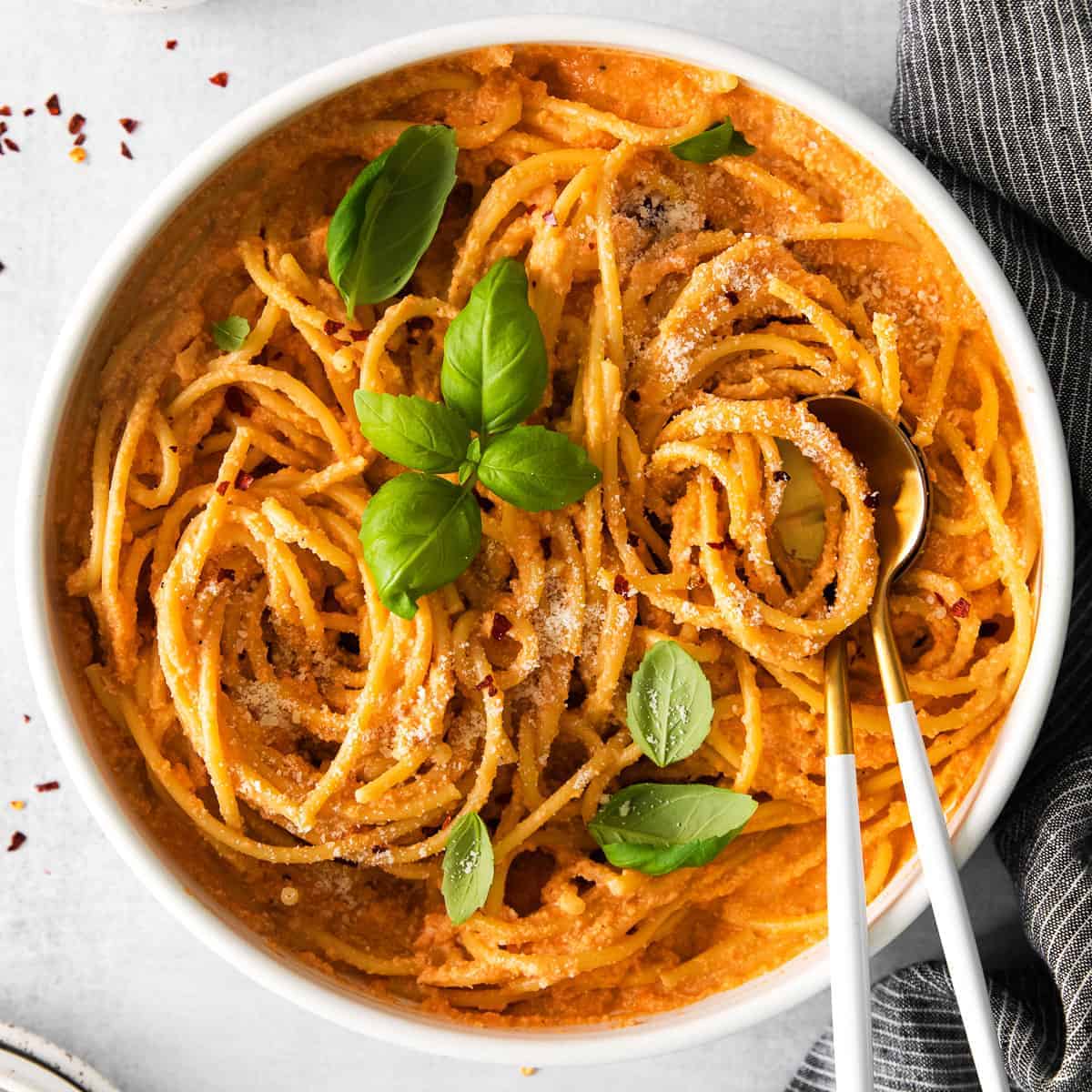Tired of the same old tomato sauce? Prepare your taste buds for a culinary adventure! This exploration dives into the vibrant world of creative vegetarian pasta sauces, showcasing globally inspired recipes, unexpected flavor combinations, and elevated gourmet creations. We’ll journey from the familiar comfort of Italian classics to the exotic spice markets of India and beyond, unveiling unique sauce bases and innovative techniques that will transform your pasta nights. Get ready to expand your culinary horizons and discover exciting new ways to enjoy this beloved dish.
From roasted sweet potato bases to sun-dried tomato and artichoke pairings, we’ll uncover the secrets to crafting visually stunning and incredibly flavorful vegetarian pasta sauces. Each recipe is meticulously detailed, guiding you step-by-step through the process, ensuring even novice cooks can achieve restaurant-quality results. Whether you’re a seasoned chef or a kitchen beginner, this guide offers inspiration and practical techniques to elevate your pasta game to a whole new level.
Globally Inspired Vegetarian Pasta Sauces

Embark on a culinary journey around the world with these five unique vegetarian pasta sauces, each offering a vibrant tapestry of flavors and textures far removed from the familiar comfort of traditional Italian tomato-based sauces. These recipes showcase the versatility of vegetables and spices, transforming simple pasta dishes into exciting global feasts.
Globally Inspired Vegetarian Pasta Sauce Recipes
The following recipes offer a diverse range of tastes and textures, showcasing the exciting possibilities of vegetarian pasta sauces beyond the familiar Italian classics. Each sauce provides a distinct flavor profile, reflecting the culinary heritage of its inspiration.
| Sauce Name | Cuisine | Key Ingredients | Description |
|---|---|---|---|
| Spicy Peanut Noodles | Thai | Peanut butter, soy sauce, lime juice, sriracha, ginger, garlic | A creamy, spicy, and tangy sauce with a vibrant reddish-orange hue, offering a complex interplay of sweet, savory, and spicy notes. |
| Saag Paneer-Inspired Pasta Sauce | Indian | Spinach, coconut milk, ginger, garlic, garam masala, paneer (optional) | A vibrant green sauce with a creamy texture and rich, earthy flavor profile, punctuated by warming spices. The optional paneer adds a delightful, subtly salty element. |
| Chipotle Black Bean Sauce | Mexican | Black beans, chipotle peppers in adobo sauce, corn, onion, cumin, cilantro | A smoky, slightly spicy sauce with a deep brown color, showcasing the earthy flavors of black beans and the subtle heat of chipotle peppers, complemented by the sweetness of corn. |
| Miso-Glazed Eggplant Pasta Sauce | Japanese | Eggplant, white miso paste, mirin, soy sauce, sesame oil, ginger | A savory, umami-rich sauce with a deep brown color, the sweetness of mirin balancing the salty miso and the earthy eggplant. A glossy sheen reflects the sesame oil. |
| Roasted Red Pepper and Walnut Pesto | Italian-inspired | Roasted red peppers, walnuts, garlic, Parmesan cheese (optional), olive oil, basil | A vibrant red sauce with a creamy texture, showcasing the sweetness of roasted red peppers and the nutty richness of walnuts. The optional Parmesan adds a sharp, salty counterpoint. |
Detailed Recipes
Each recipe below provides a step-by-step guide to creating these globally inspired vegetarian pasta sauces.
Spicy Peanut Noodles (Thai):
- Combine 1/2 cup peanut butter, 1/4 cup soy sauce, 2 tablespoons lime juice, 1 tablespoon sriracha (or to taste), 1 tablespoon grated ginger, and 2 cloves minced garlic in a bowl. Whisk until smooth.
- Add 1/4 cup water to thin the sauce to your desired consistency.
- Toss with cooked pasta and garnish with chopped peanuts and cilantro.
Saag Paneer-Inspired Pasta Sauce (Indian):
- Sauté 1 chopped onion and 2 cloves minced garlic in olive oil until softened.
- Add 10 oz chopped spinach, 1/2 cup coconut milk, 1 teaspoon ginger, 1 teaspoon garam masala, and salt to taste. Simmer until spinach is wilted.
- Blend until smooth. Stir in crumbled paneer (optional) before serving.
Chipotle Black Bean Sauce (Mexican):
- Sauté 1 chopped onion and 1 bell pepper in olive oil until softened.
- Add 1 (15-ounce) can black beans (rinsed and drained), 1 (4-ounce) can chipotle peppers in adobo sauce (finely chopped), 1 cup corn kernels, 1 teaspoon cumin, and salt to taste. Simmer for 15 minutes.
- Blend until smooth. Garnish with chopped cilantro.
Miso-Glazed Eggplant Pasta Sauce (Japanese):
- Roast 1 medium eggplant until tender.
- Scoop out the flesh and mash. Combine with 2 tablespoons white miso paste, 1 tablespoon mirin, 1 tablespoon soy sauce, 1 teaspoon sesame oil, and 1 teaspoon grated ginger.
- Simmer until slightly thickened.
Roasted Red Pepper and Walnut Pesto (Italian-inspired):
- Roast 2 red bell peppers until charred.
- Peel and chop the peppers. Combine with 1/2 cup walnuts, 2 cloves garlic, 1/4 cup grated Parmesan cheese (optional), 1/4 cup olive oil, and fresh basil leaves in a food processor.
- Blend until smooth.
Creative Sauce Base Explorations
Unleashing the potential of vegetables beyond the familiar tomato base opens a world of vibrant flavors and textures in pasta sauces. These three inventive sauce bases, crafted from roasted sweet potatoes, cauliflower, and butternut squash, demonstrate the versatility of vegetables and offer a departure from traditional Italian-style sauces. Each base offers a unique culinary journey, showcasing the depth and complexity achievable with thoughtful preparation.
Roasted Sweet Potato Sauce Base
This deeply colored sauce boasts a naturally sweet and earthy flavor profile. Begin by roasting 2 lbs of sweet potatoes, cubed, with 2 tbsp olive oil, salt, and pepper at 400°F (200°C) for 30-40 minutes, until tender and slightly caramelized. The roasting process intensifies the sweetness and creates a lovely depth of flavor. Once cool enough to handle, the sweet potatoes are blended until smooth, creating a velvety base. A touch of maple syrup or brown sugar can be added for extra sweetness, depending on the desired level.
Cauliflower Sauce Base
The cauliflower base offers a surprisingly creamy and subtly nutty flavor. Start by roasting 1 large head of cauliflower, cut into florets, with 2 tbsp olive oil, 1 tsp garlic powder, and salt and pepper at 400°F (200°C) for 30-40 minutes, until tender and slightly browned. The roasting brings out the cauliflower’s natural sweetness and adds a depth of flavor. After roasting, the cauliflower is blended until completely smooth, creating a remarkably creamy texture reminiscent of a cashew-based sauce, but entirely vegan.
Butternut Squash Sauce Base
This rich and vibrant sauce delivers a smooth, subtly sweet, and slightly nutty flavor. Begin by roasting 1 medium butternut squash, peeled, seeded, and cubed, with 2 tbsp olive oil, 1 tsp sage, and salt and pepper at 400°F (200°C) for 30-40 minutes, until tender. The roasting enhances the squash’s natural sweetness and creates a complex flavor profile. The roasted squash is then blended until smooth, resulting in a luxuriously creamy sauce. A pinch of nutmeg can enhance the warmth and complexity of the flavor.
Thickening Methods for Unique Sauce Bases
These unique sauce bases benefit from a variety of thickening methods, each imparting a slightly different texture and mouthfeel.
- Reduction: Simmering the sauce gently over low heat for an extended period allows excess water to evaporate, concentrating the flavors and naturally thickening the sauce. This method works particularly well for the sweet potato and butternut squash bases, intensifying their inherent sweetness. Imagine the rich, glossy consistency achieved, clinging beautifully to the pasta.
- Starch Thickening: A slurry of cornstarch or arrowroot powder mixed with cold water can be whisked into the simmering sauce. This provides a quick and effective thickening method, particularly useful for the cauliflower base which might require a slightly more robust thickening agent. The result is a smooth, creamy sauce with a slightly glossy sheen.
- Pureed Vegetables: Adding a small amount of cooked and pureed vegetables, such as carrots or parsnips, can subtly thicken the sauce while adding depth of flavor. This method works well with all three bases, subtly adding complexity without overpowering the primary vegetable flavor. Imagine the vibrant colors deepening and the textures melding together for a delightful experience.
Texture and Flavor Profile Comparisons
Compared to traditional tomato-based sauces, these unusual vegetable bases offer a significantly different sensory experience. Tomato sauces tend to be bright, acidic, and slightly watery. In contrast, the sweet potato sauce offers a smooth, velvety texture with a deep, caramelized sweetness and earthy undertones. The cauliflower sauce provides a surprisingly creamy and nutty texture, a welcome contrast to the acidity of tomato. The butternut squash sauce offers a luxurious creaminess with a subtle sweetness and warmth, a comforting and satisfying alternative to the sharpness of a tomato sauce. Each sauce boasts a unique personality, showcasing the diverse culinary possibilities beyond the traditional tomato.
Step-by-Step Recipe Creation and Presentation
This section provides a detailed, step-by-step recipe for a vibrant and flavorful roasted red pepper and walnut pasta sauce, perfect for showcasing the versatility of vegetarian cooking. The recipe emphasizes fresh, high-quality ingredients and simple techniques to create a sauce that’s both delicious and visually appealing. Each step is carefully described to ensure even novice cooks can achieve excellent results.
Roasted Red Pepper and Walnut Pasta Sauce Recipe
This recipe delivers a rich, subtly sweet, and nutty pasta sauce, ideal for a weeknight meal or a more elegant dinner party. The roasting process intensifies the sweetness of the peppers, while the walnuts add a delightful textural contrast and depth of flavor.
- Roasting the Peppers: Preheat your oven to 400°F (200°C). Halve two large red bell peppers, remove the stems and seeds, and place them cut-side down on a baking sheet lined with parchment paper. Drizzle with a tablespoon of olive oil and season generously with salt and pepper. Roast for 30-40 minutes, or until the skins are blistered and charred in places. Remove from the oven and let them cool slightly before peeling off the skins.
- Toasting the Walnuts: While the peppers are roasting, toast ½ cup of walnut halves in a dry skillet over medium heat for 5-7 minutes, stirring frequently, until fragrant and lightly browned. Be careful not to burn them.
- Preparing the Sauce Base: In a food processor, combine the roasted red peppers (after peeling), toasted walnuts, 2 cloves of minced garlic, 2 tablespoons of olive oil, the juice of ½ a lemon, and a pinch of red pepper flakes (optional). Process until smooth and creamy, scraping down the sides as needed. Add a tablespoon or two of pasta water if needed to achieve the desired consistency.
- Simmering and Seasoning: Transfer the sauce to a small saucepan and simmer over low heat for 5-10 minutes, stirring occasionally, to allow the flavors to meld. Taste and adjust seasoning with salt, pepper, and lemon juice as needed. A touch of balsamic vinegar can also add complexity.
- Serving: Toss the sauce with your favorite cooked pasta (1 pound of pasta works well). Garnish with freshly grated Parmesan cheese (optional, for a non-vegan version), chopped fresh basil, and a sprinkle of extra walnuts. Serve immediately.
The key to this recipe’s success lies in properly roasting the peppers. Don’t rush the process; allow them to become deeply caramelized for the most intense flavor.
Final Dish Presentation
The finished dish is a vibrant tapestry of color and texture. The sauce is a rich, deep red-orange hue, punctuated by flecks of toasted walnut. The aroma is intoxicating – a blend of sweet roasted peppers, earthy walnuts, and a hint of garlic. The texture is luxuriously creamy, with a pleasant crunch from the walnuts providing a delightful contrast to the smooth pasta. Each bite offers a symphony of flavors – the sweetness of the peppers, the nuttiness of the walnuts, the sharpness of the lemon, and a subtle warmth from the red pepper flakes. The overall effect is both comforting and sophisticated, a testament to the power of simple, high-quality ingredients.
Unleash your inner culinary artist and embark on a flavorful journey with these inventive vegetarian pasta sauces. We’ve explored global cuisines, experimented with unexpected ingredients, and elevated classic techniques to create a collection of recipes that are both delicious and visually captivating. Remember, the beauty of cooking lies in experimentation, so don’t hesitate to adapt these recipes to your own tastes and preferences. So, grab your aprons, gather your ingredients, and prepare to create pasta masterpieces that will impress even the most discerning palates. The possibilities are as endless as your imagination!
Popular Questions
Can I substitute ingredients in these recipes?
Absolutely! Feel free to adjust ingredients based on your preferences and dietary needs. However, keep in mind that substituting key ingredients might alter the overall flavor profile.
How long do these sauces last in the refrigerator?
Most of these sauces will last for 3-5 days in an airtight container in the refrigerator. Always ensure the sauce is thoroughly cooled before refrigerating.
Can I freeze these sauces?
Yes, many of these sauces freeze well. Allow them to cool completely before freezing in airtight containers. They should last for 2-3 months in the freezer.
What types of pasta pair best with these sauces?
The best pasta type depends on the sauce. Thicker sauces pair well with wider pasta shapes like penne or rigatoni, while thinner sauces are better suited for long pasta like spaghetti or linguine.


